Archive
Emerging from Darkness
When is it time to emerge from your cave and start playing in person?

Well, by now we’ve all been through it. Right when we started to think that we were going to get back in the saddle here at Skyland Games, the pandemic hit. And it persisted. And it persisted. In some ways, we had more time than we ever had before to write and reflect, and review ways to game more successfully online, but I’ll be damned if we just could not bring ourselves to do it.
Things were pretty dark. We all know that. Is it surprising to be unmotivated in all that? No. So please forgive us our long absence. We have slowly started to feel a little safer making our way out to game in person, and we’re currently running one online game and one in-person game for those who crave the in-person interaction and can handle the risk of possible infection, limited though it may be. We gathered in person as well at Free RPG Day which was this past weekend, all of us meeting at our FLGS The Wyvern’s Tale for some DCCRPG (you may be able to soon get a free PDF of Goodman Games’ offering Danger in the Air — click that for details). It was great to see things return to a semblance of normalcy from the before times.
It raises the question, when do you know you’re ready to return to in-person gaming? Here are some suggestions.
PARTY VOTE
Decide whether or not you’re going to require the vote to be unanimous, or majority rule. If you’re going with majority rule, you’ll want to discuss whether or not people voting against are going to honor the vote or have to abstain. If so, you might want to consider some of the other options below. But to run an anonymous poll among your friends is easy and can be accomplished with some free websites like Xoyondo. This can take the pressure off of some of your friends who might feel like they’re spoiling someone’s fun or pressuring others to do something their not ready to do.

STAY VIRTUAL AND CRY ABOUT IT
Until the virus is gone, which it looks like may be never, you can stay virtual. Yes, it may be a poor simulacrum, a shadow of real gaming, but you have to admit there are some advantages. You save gas money which as of this writing is hitting close to $5/gallon. You can use that huge catalog of virtual tokens you got from Forgotten Adventures, load up Roll20.net and start up DnDBeyond.com and you’re playing in minutes. And when you’re done, you can go upstairs and go right to sleep! You can still use all those great virtual resources you gathered during the pandemic, many of which are probably easier and faster than trying to unreliably do math in your head.
If there is one thing the pandemic did for us as gamers, it was making us figure out how to successfully game virtually. If you’re playing online, take the time to set it up right. We’ve never been fond of the in-app video chat with roll20, so we use a separate Discord server. It’s free, works fairly reliably, and accommodates good audio and passable video I’m told, though I’ve never used it that way.
I think video would probably enhance the online experience, but enough of us run these games on potatoes disguised as computers so we don’t push our luck.
It’s a good opportunity to get together with that old gaming group from college, or maybe hook up with some players that have moved away. And there is always the dark depths of various LFG pages you might wade into. Tread lightly.
HYBRID
I have recently accepted that some of our players may not ever want to play in person again. Also some players have moved away and are never coming back. Our player that moved to Canada really wants to stay in the game, or at least games that were going when he left. To accomplish this, I’ve actually found that it can be rewarding to have as many as are willing to play in-person get together in the same room, with a table mic for the distant player.
I recently required this rig to accomplish just that. Blue Yeti makes a powerful mic, this setup clamping to the table and hovering boom-style over the action so you don’t have to work your miniatures around it. If you couple that with a video table, the GM can use that to mark where players and monsters are and stream that same image to roll20, to which the player can log on and play.
I have a fairly serious setup. This may not be for everyone. But we played theater of the mind for decades! And failing that, a well positioned facetime shot or screen shot can get the same feats accomplished. There may be technical frustrations however, so get it set up before your players show if at all possible.
We did something like this during the pandemic lull of 2021 when a few of us were vaccinated and thought everything was fine, but others knew better. That mixed group was significantly more fun than just being straight virtual, where interrupting each other kept us from playing our characters and telling our jokes as timely as we would have liked. But hey, those days of virtual play were iron rations. They may not have been good, but they kept us alive, didn’t they?
In the end, do what you can to keep your people together. These guys might be more than just gaming buddies, they might be your Found Family, and no one wants to be left out. It didn’t occur to me how rushing back to the table might make some people feel left out until it was too late, and I regret not weighing it a little more before we sat back down. Best we can do now is accommodate those that need to play it safe, and hope we get to a point where we all can sit down at the table again and kill orcs in person, like the gods intended. Except Gruumsh, that still pisses him off.
Baby Yoda FFG build
I would like to see the baby. Fair enough. The surprise star of the first season of the Mandalorian brought many fans joy and made a lot of people curious about the show through some truly adorable memes.

“The Child” was one of the more interesting to try and stat up, since we don’t have any other examples of that species outside of Yoda. From Yoda’s stat block in Allies and Adversaries it looks like his career is Mystic Seer judging from his talents such as Natural Mystic. I decided to go the same way with the Child. I also started with 110 initial xp and 123123 as initial characteristics, which seems plausible as a starting point for Yoda as well.
Initial xp went to boosting characteristics: Intellect, Willpower, and Presence. I chose the few initial skills granted by his career and spent the rest on talents to up his force rating, and purchase a few Force powers: Bind, Heal/Harm and Protect/Unleash, all of which we see him use on screen in one form or another during the first season.
I did homebrew one talent that doesn’t exist in FFG Star Wars: Magic Hand Thingy. Named after what Greef Karga calls it when the heroes are pursued by Moff Gideon in his TIE fighter. Here is the description: Spend all remaining strain to roll double your force rating in dice and pass out. Pips may be spent to add range, strength, control, and/or magnitude.
This power is meant to represent the few scenes in which the Child performed some crazy force feat, then immediately passed out: levitating the mudhorn, healing Greef’s nearly fatal wounds, and shielding the heroes from a flamethrower.
I think it is a nice thematic way to bring that power to the table and gives the PC playing The Child a great opportunity to turn the tide when the chips are down. See what you think.
I’ll be running two sessions of my Mandalorian game at Mace West in Asheville, NC next week! Hope to see you there!
The Mandalorian – Mace West Preview
MACE West is less than a month away! The annual western addition of Mid-Atlantic Convention Expo returns a bit earlier than in previous years (February 28 – March 1), but in the same space at the DoubleTree in Asheville, just outside the Biltmore estate.
Registration is already open. Get your tickets, sign up for games, and I’ll see you there!
I’ll be running DCCL Acting Up in Lankhmar, as well as two slots of my FFG Star Wars adventure that picks up immediately where the Mandalorian TV season 1 ends (spoiler warning if for some reason you have failed to devour the first season of Mandalorian).
After watching the last few episodes a few more times, I would still like to stat out IG-11 and Kuill, but they are both pretty much irrefutably dead after the last episode. One could argue you could rebuild IG-11, but his self-destruct device was purpose-built to avoid capture and his design being copied. The only reason Kuill was able to rebuild him earlier in the show was thanks to Mando’s well-placed headshot.
The pre-gens for my table of Mandalorian Season 2 will be: Mando, Cara Dune, Greef Karga, The Armorer, Paz Vizla (Mandalorian heavy), and the Child. Today I’ll share my build for Carasynthia Dune of Alderaan.
I considered making her a Soldier Heavy from Age of Rebellion, but went with Soldier Commando instead. Especially considering the addition of Paz Vizla, who is most definitely a Hired Gun Heavy, Commando seemed like the best choice for her. Added to the core Solider skills of Athletics, Brawl, Knowledge (Warfare), Medicine, Melee, Ranged (Light) and Ranged (Heavy), Commando adds another Brawl, another Melee, Resilience and Survival. The skills alone do well to describe what we have seen on the screen so far. The talents only further support Commando as the best choice for Cara. As a human you can take two non-career skills, and I chose Gunnery and Cool. I’m building these pre-gens out with initial XP+200. I used her initial 110 as a human to increase her Brawn up to 4 and Agility up to 3. I eventually purchased the talents to get to Dedication and increase her Agility to 4.
As one may expect, there are plenty of ranks of Grit and Toughened in the Commando talent tree. I purchased a few of those, as well as Point Blank which adds damage to Ranged attacks at short and engaged range. Durable reduces crit results suffered by 10. Armor master increases soak by 1 when searing armor. Feral Strength adds 1 damage to Brawn and Melee attacks. Perhaps most thematically, Heroic Fortitude allows Cara to ignore effects of crits to Brawn and Agility until the end of the encounter. On balance, I think this build fits quite well for what we’ve seen from Cara on screen so far.
Her equipment posed a few interesting challenges. Most notably, her heavy rifle does not appear to have appeared in the Star Wars universe before. The power cell is similar to the RT-97C from Battlefront, but it is under the rifle which features two barrels and a carrying handle she uses to stabilize it while firing. To stat it out, I started with a Heavy Blaster Rifle and added an Augmented Spin Barrel, Forearm Grip, and Optimized Energy Cell. The one from the show doesn’t actually spin, but mechanically it just adds one base damage while providing an additional barrel. The Forearm Grip reduces the difficulty for engaged range heavy checks, and the Optimized Energy Cell accounts for the massive power cell and ensures she will rarely run out of ammo.
I gave her Rebel Heavy Battle Armor (Soak 2) which when you add her 4 Brawn and Armor Master gives her a very beefy 7 soak. Beyond that, I added a simple blaster and a vibroknife as backup weapons. In the show her pistol has a cool looking scope on it, but I didn’t find a weapon modification that described that well and fit on a pistol.
Once I stat out the rest of the PCs I’ll post them here. As of this writing, there are still a few slots left for the tables I’m running. There are a ton of great gaming events happening all weekend: board games, historical wargames, and even a greek pantheon themed LARP. See you at MACE West!
DCC RPG Annual Vol. 1 Review

It has been almost a year since we have published anything on this blog. Life can get busy, but I have a particularly adorable excuse. My wife and I have wanted to adopt for years, and in October 2018 we got the call. We’ve spent the majority of this last year learning how to be parents. It has been amazing to see this little zero level gain new skills and bring such joy to so many people. Now that we have mastered parenting (ha!), we both wanted to get back to creative pursuits and hobbies.
While I may have not blogged about RPGs, I certainly haven’t stopped playing them or buying stuff! Just counting Goodman Games kickstarters that have shipped since I last posted we have had MCC, DCC Lankhmar, and most recently the DCC Annual Vol. 1. I’ve decided to try and catch up in reverse chronological order, so we’ll start with the Annual.
For those of us die hard DCC fans, the “Annual” had been talked about in hushed tones on the now defunct G+ (RIP) since at least 2013, if not earlier. The years went by and still no Annual. Was the gongfarmer’s almanac the annual? No, that was community-created content. The Annual would be from the core Goodman Games writers. It eventually became synonymous for things that would be nice to have, but would not likely see the light of day; the vaporware of RPGs.

Then in late October of 2018, the kickstarter for the Annual was launched. I backed at the foil level. Due to a shipping/fulfillment snafu, I only received my physical copy recently. I had skimmed the PDF version, but didn’t do a deep dive until recently. The tome weighs in at 208 pages.
The chapter numbers mirror the core book, which seems confusing and unnecessary. While the first section is a welcome addition expanding the official material on the pantheon of gods just mentioned by name in the core book, starting on Chapter 5 seems like on odd choice. It would be one thing if this was a direct expansion of the core book and you could plug these sections in to the original, but since they are two separate volumes it just makes navigating the Annual a bit weird.
That said, the contents of the strangely numbered chapters are pretty excellent. Chapter 5 provides background information for several of the gods mentioned in the cleric section of the core book such as Cadixtat, Justicia, Shul and Malotoch, however it does not detail all of them. It does provide some satisfying backstory for those included, as well as several Lay on Hands manifestations to add some more flavor to the next healing attempt. Most provide a few deity-specific divine favors and titles for the first five PC levels. Each entry also includes specific disapproval tables, and spells for levels 1, 3 and 5 called canticles.
Chapter 6 extends the Quests & Journeys chapter of the core book by quite a bit. Included is a fairly detailed table of 24 mini-adventures that could be run in between larger quests. This is followed by several pages detailing a lost utopian land of Mu. While not providing a specific adventure, it provides descriptions of the inhabitants, crystal technology, and interesting places upon which a judge could launch any number of quests.

Chapter 7 is labeled Judge’s Rules like the core book, but is a collection of more patrons for wizards and elves. Several of these I recognize from specific adventures, while others may be new or just unfamiliar to me. Each entry includes some background information, invoke patron results, patron taint, spellburn results and patron spells for level 1, 2 and 3.
As in the core book, Chapter 8 is dedicated to Magic Items. This includes a very detailed section on crafting magic rings with a vast number of tables to ensure each ring created would be unique. The next section describes patron weapons which is a process (and tables!) that describes imprisoning a PC in an item for angering their patron. This curse always has a condition upon which it may be lifted. It also has rules for wielding patron weapons, and a mechanic in which a patron weapon could exert its will on the wielder and dominate the bearer. There is also a table of magical books and a few that have detailed descriptions of magical effects from reading them. My favorite part of this chapter is the named swords section. It dedicates an entire page to each sword. Half of the page is a detailed illustration, the other half is a lengthy backstory and list of powers.

The last main chapter provides options for making monsters more memorable. There are several long entries of individual creatures, but also sections which include tables to make what could be mundane creatures into something unique. This includes tables for randomizing bugs, reptiles, constructs, giants, therianthropes (were-creatures) and general mutations. The chapter concludes with a section on monstrous patronage. This allows a judge to provide some supernatural aide for monsters similar to PCs invoking their patrons. This could be fun if used sparingly, and would be pretty terrifying on the player side of the table the first time it is used.

The book closes with Appendix M – Moustaches. This is a hilarious group of rules and tables about moustaches culminating in the moustache duel. “But sometimes things get ugly, and then folks with a ‘stache must have a clash.”
I think it is great this book finally went into production. It is an excellent collection of details and tables to expand DCC, without feeling like it is adding complicated sub-systems or dreaded rules-bloat. I would recommend it for fans of DCC who want to add a bit flavor and detail to their PCs, monsters, magic items and moustaches.
Trigger Warning: Everything
Very soon, we’ll be running “Inferno Road” at this year’s Mace West convention here in lovely Asheville, North Carolina. Both Kevin and Scott got a chance to play it at this year’s GenCon, but I wasn’t able to as it coincided with games I was running. It’s an insane DCCRPG death metal tournament in a nightmarish hellscape cranked up to 11 and beyond. Sex, drugs, and rock and roll are just the beginning. The index says “Trigger Warning: Everything” and the pages following live up to that fact. Not for kids, not for the faint of heart and not for everyone. We’ve said more than once we could be asked to never return, but it will definitely be worth it.

Inferno Road binders for the Judges… we may need to burn these when done to be safe.
Here’s the basics:
INFERNO ROAD @ MACE WEST 2018
Saturday, March 10th
Asheville, North Carolina
Slaved to the overlords of Hell… you begin as a soulless grub in a sea of grubs, endlessly writhing in the burning pits of the inferno. Your eternity is suffering with the gnawing hunger for a soul… any soul… ALL souls. Plucked from obscurity and forced on board a Hellwagon in service to a Duke of Hell, you and your ‘companions’ race to overtake Satan’s Wives, pregnant with fresh souls for the Prince of Darkness. With every soul you devour your power will grow, perhaps enough to take on the the Devil himself?
RATED M FOR MATURE
Trigger Warning: EVERYTHING
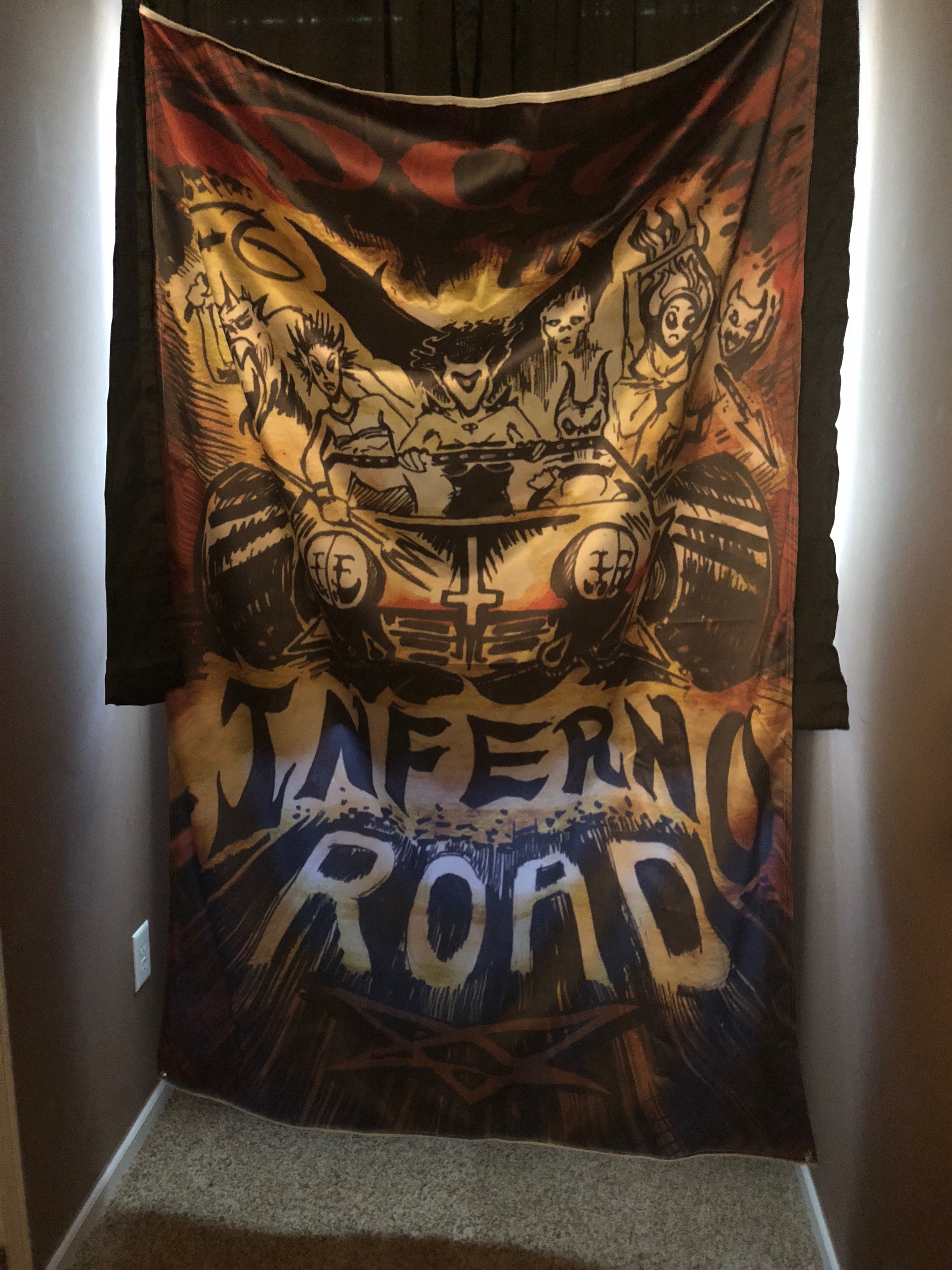
Giant 4′ x 6′ banner which we’ll have hanging behind the tables, calling those seeking ruination and destruction to join in the insanity that is “Inferno Road”
We’re planning on two tables battling head to head and as such have had to make some adjustments to the mechanics and the storyline, but the core remains the same. There will be prizes galore and a trophy for the winner.
On top of that, the Asheville DCCRPG Road Crew gang will be running a few games, notably “Blades Against Death” by Harley Stroh which Kevin will be handling and I’m scheduled to run “Blessing of the Vile Brotherhood” also by Harley Stroh. More MCC and DCC will be played after hours and on the schedule. There’s also plenty of other games for many systems, and it’s always a great weekend here in Asheville.
You can register for Mace West at THIS LINK. Come play with us… forever… and ever… and ever…
Genesys Review

I spent some time over the holidays digesting the new Genesys Core Rulebook from Fantasy Flight games. As an avid fan of the Star Wars system that basically uses the same core mechanics, I figured I would enjoy FFG’s adaptations of those same concepts to other settings. The short version is, I was right! This will be my go-to system for creating unique settings, or adapting popular worlds (and IPs!) that either don’t have an RPG of their own, or the licensed RPG leaves a lot to be desired.
In my experience, other one-system-fits-all RPGs like Savage Worlds, FATE, or GURPS were OK, but failed to be really satisfying. Since you have to be able to do everything, they tend not to do anything exceedingly well.
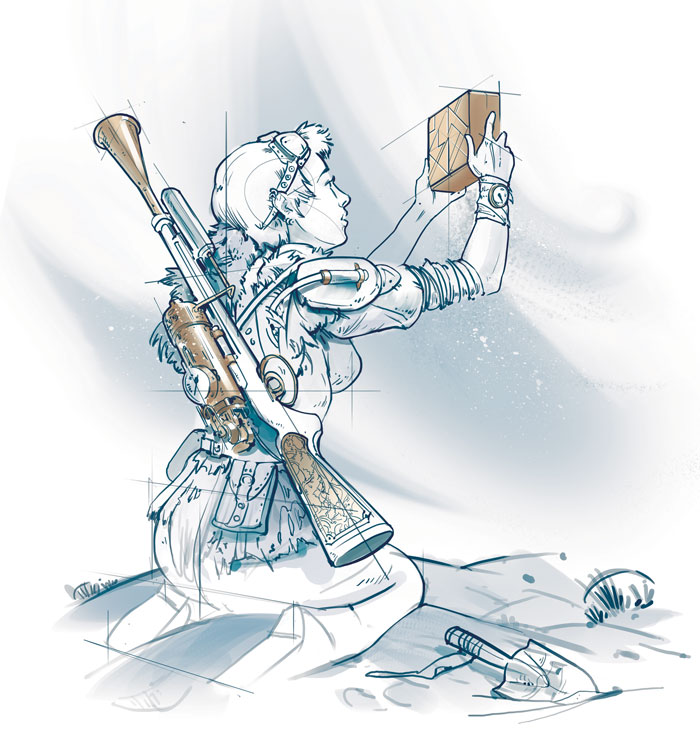 Genesys uses the narrative dice system from their Star Wars line with very few modifications. While the symbols on the dice are different (and some could argue more clear) if you have the Star Wars dice you can certainly use those, and do not have to buy new dice. The terminology is the same: Success/Failure, Advantage/Threat, Triumph/Despair, Boost/Ability/Proficiency dice, Setback/Difficulty/Challenge dice etc. The one omission being the Force die. Destiny points are called Story points in Genesys, and you start out with a static pool of one point per PC in the player pool, one point in the GM pool. I personally will likely house-rule this and include a roll of the force die to see whether the winds of fate are blowing for or against the PCs. Having a larger pool of destiny/fate/story points is more fun in my opinion.
Genesys uses the narrative dice system from their Star Wars line with very few modifications. While the symbols on the dice are different (and some could argue more clear) if you have the Star Wars dice you can certainly use those, and do not have to buy new dice. The terminology is the same: Success/Failure, Advantage/Threat, Triumph/Despair, Boost/Ability/Proficiency dice, Setback/Difficulty/Challenge dice etc. The one omission being the Force die. Destiny points are called Story points in Genesys, and you start out with a static pool of one point per PC in the player pool, one point in the GM pool. I personally will likely house-rule this and include a roll of the force die to see whether the winds of fate are blowing for or against the PCs. Having a larger pool of destiny/fate/story points is more fun in my opinion.
This book packs a lot of great material in its 256 pages, for a very reasonable MSRP of $39.95. The system has certainly benefited from years of refinements in designing an entire shelf worth of Star Wars supplements. Sections of it read like a design guide for creating balanced skills, talents, species, and items. It offers insights in to the design process and provides a pretty elegant way to design a skill tree that feels both familiar, yet provides the tools and guidance to customize your setting.
Included are some basic profession archetypes like Laborer, Intellectual, and Aristocrat which could be adapted to any of the outlines of included settings like Fantasy, Steampunk, Space Opera, Sci-Fi, Modern and Weird War. All of the included settings have brief sections on possible species/races, items and adversaries. While not being exhaustive, they certainly cover the main tropes for each genre that provide the blueprint to allow endless expansion.
One section that got a significant overall is Social Encounters. Star Wars was moving in this direction with a lot of the more recent sourcebooks for socially-focused characters, but Genesys takes it a few steps further. As part of a social encounter (and potentially during combat using social skills!) PCs and NPCs can trade verbal barbs that actually cause strain damage equal to uncancelled successes similar to typical combat checks. An opponent is defeated once you exceed their strain threshold. All PCs and Nemesis NPCs have a Strength, Flaw, Desire, Fear, and Motivation that can be learned or accidentally revealed during the course of the encounter to the advantage of their opponent in future rounds. I think the key to successfully running these will be to allow the story to drive the mechanics rather than the other way around. PCs will still need to be fairly clever and creative in their social maneuverings, but the dice and motivations may be a fun way to represent or even inspire the ebb and flow of these encounters.
 There are also a few optional rule sets that make more sense in some settings than others. The vehicle rules/combat are very similar to Star Wars with very few additions. I did notice an additional range band added beyond extreme: Strategic range. This could be used in a variety of settings, but is defined by not being able to see each other with the naked eye, but only through some other means: sensors, spyglasses, radar etc. The magic rules are fairly unique and will be a pretty big departure for those used to playing wizards in D&D or similar systems. Spells are defined in broad strokes, allowing PCs to flavor them as they like, or as would be appropriate for their character. Examples include Attack, Augment, Barrier, Conjure, Curse, Dispel, Heal and Utility. Spells are divided into three main skills: Arcana, Divine, and Primal. Casters can also add special effects by increasing the number of difficulty dice. Turn a fire bolt into a fireball by adding the Blast quality and one difficulty die. Empower an attack to do damage equal to twice the characteristic linked to the skill for two extra difficulty dice. Bigger, badder spell? Harder to cast. Very elegant.
There are also a few optional rule sets that make more sense in some settings than others. The vehicle rules/combat are very similar to Star Wars with very few additions. I did notice an additional range band added beyond extreme: Strategic range. This could be used in a variety of settings, but is defined by not being able to see each other with the naked eye, but only through some other means: sensors, spyglasses, radar etc. The magic rules are fairly unique and will be a pretty big departure for those used to playing wizards in D&D or similar systems. Spells are defined in broad strokes, allowing PCs to flavor them as they like, or as would be appropriate for their character. Examples include Attack, Augment, Barrier, Conjure, Curse, Dispel, Heal and Utility. Spells are divided into three main skills: Arcana, Divine, and Primal. Casters can also add special effects by increasing the number of difficulty dice. Turn a fire bolt into a fireball by adding the Blast quality and one difficulty die. Empower an attack to do damage equal to twice the characteristic linked to the skill for two extra difficulty dice. Bigger, badder spell? Harder to cast. Very elegant.
My only complaints are mostly aesthetic, which is a first for FFG RPGs. I knew going in we weren’t going to have the incredible art that drives the Star Wars universe, but the original art we do get are basically just sketches. I get its a toolkit/blueprint but not only does it look rough, it is much more sparse. At least give us a lot of it if its going to take a quarter of the time. Beyond that, the headings and subheads are in a very compact all-caps font in two shades of blue. Gross. Ideally, the various setting-specific books will have their own layout and design team, because this book is below par.
That being said, I would highly recommend picking this one up in print or PDF! One benefit of not being under the yoke of the Disney/Star Wars license is modern digital formats! For an example of what can be built using the system, check out the Fallout theme over at d20 radio.
History Check: Gary Gygax High School Yearbook
A facebook group I frequent auctions numerous gaming items, sometimes common and sometimes very rare. Several of the members are known gaming industry talents, and others are just collectors like myself. At the end of November, Garrett Ratini put up an item that was a rare gem from his collection. It wasn’t a game book, but books containing a surprisingly rare set of photos that made up a part of gaming history. And how the auction ended is where the real surprise happened.
The items auctioned were the 1953 and 1954 years of the Geneva Log, the Lake Geneva High School yearbook. It was during these years that Gary Gygax, Don Kaye and Mary Powell were all in attendance. A treasure for the gamer who wants to own a piece of history, but especially for the rarity of the photos inside. To appreciate just how rare, you have to know a little something about the history of these three individuals.

Gary Gygax, for one, did not finish high school, though did finish his degree years later. A few months after his father passed, he dropped out of high school in his junior year. These volumes then contained rare pictures of him as a student.
Secondly, Don Kaye is depicted in the book as well. Don Kaye, a close childhood friend of Gygax from age 6, co-founded Tactical Studies Rules (TSR) with Gygax and made one of the first Dungeons & Dragons characters, the infamous Murlynd. While the depiction of these two legends in one book might not appear to be noteworthy in itself, it is one of the few rare pictures of Don Kaye.

TSR was founded in 1973 by Gygax and Kaye. Later, Brian Blume bought in and supplied the capital to allow the publication of Dungeons and Dragons. However, Kaye suffered from a heart condition and needed surgery. He never disclosed this to his partners, and died of a heart attack before the scheduled surgery could take place, dying at age 36 just as Dungeons and Dragons was beginning to gain momentum. As a result, few public pictures of Don Kaye exist.
Mary Jo Powell was a friend of Kaye and Gygax, and was wooed by Kaye for some time. However, Gygax was also smitten, and proposed marriage at 19 years old. Kaye was upset enough to not attend the wedding, though they later reconciled. Ernie Gygax recently posted a picture of Mary Jo the day after the proposal, shown below:

Mary Jo once suspected Gary of having an affair while she was pregnant with her second child, but going to confront him in a friend’s basement, found him sitting with friends around a map covered table. She may have been the first of what my wife calls “Gaming Widows” (being spouses left by the wayside for the husband that games too much).
Garrett Ratini put these items up for auction, and the true collectors of gaming history began to come out to bid. The buyout price for the books was $1,200.00 and likely that number would have been met, I suspect, knowing the habits of this community of bidders. But an unexpected bidder placed a bid at somewhere around the $400 mark, and that was Luke Gygax himself, founder of Gary Con and Gary Gygax’s son.
With the permission of all involved, Garrett terminated the auction and gifted the books to Luke. Now, these books and images of his mother and father are with him, where they truly belong.
Pre-digital history like this is easily lost, and is not on the radar of many historians, with the exception of Michael Witwer and Shannon Appelcline. Hopefully books like this will make it into the archives like the one held at GenCon 50 this past year. Fortunately, I believe we can anticipate these books being treasured by the Gygax family, both for themselves and for posterity.

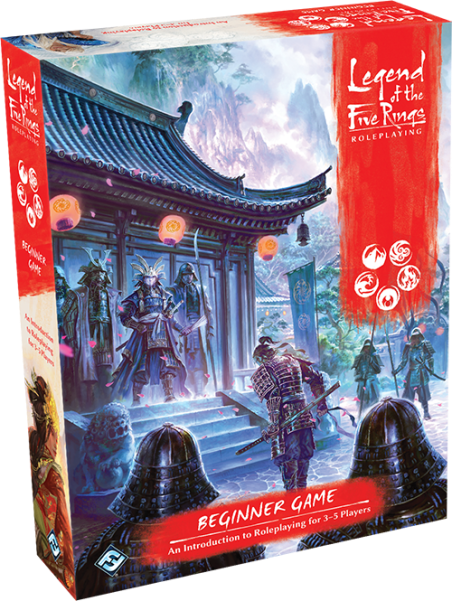


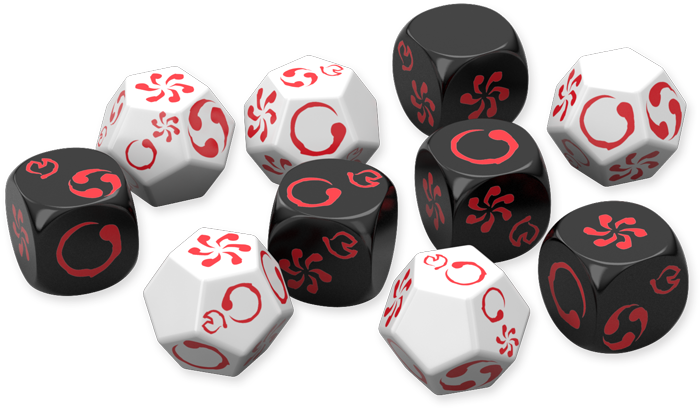


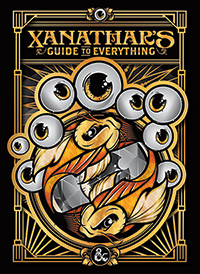


 DnD Blogs
DnD Blogs Game Night
Game Night NaGa DeMon
NaGa DeMon RPGBA
RPGBA
You must be logged in to post a comment.